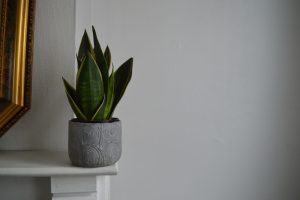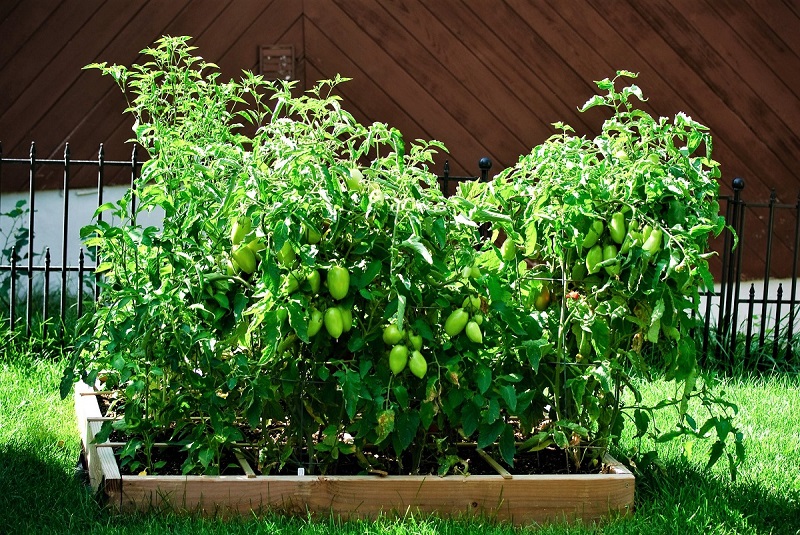
Square-foot gardening is a method that divides a raised bed into equal squares, roughly one foot in length each. When practiced correctly, the system uses less garden space to grow vegetables, and its maintenance requires no pesticides or tools. The method was developed by the engineer and hobby gardener, Mel Bartholomew, in the 1970s.
Bartholomew devised the system to allow gardeners to grow more food for each square foot devoted to gardening. The signature elements of square-foot gardening are raised beds established along 4-by-4 squares to allow easy access from all sides. However, the beds can be anywhere from 2-by-4 feet to 4-by-12 feet.
Growing Food in a Square-Foot Garden
Contents
The grids that organize each box into one-foot squares make it easy to track planting and harvest. They likewise help you pack more vegetables into a tight space.
Many gardeners have successfully employed variations of the square foot garden to grow vegetables in their backyards, on patios, decks, and rooftop gardens.
Starting a square-foot garden in six effortless steps offers numerous advantages that make it an attractive option for gardeners of all skill levels. Here are some of the benefits:
- Space Efficiency: Square-foot gardening maximizes the use of available space by dividing the garden into small, easily manageable squares. This approach allows you to grow a variety of plants in a limited area, making it ideal for small yards, balconies, or urban spaces with limited space.
- Simplified Planning and Planting: The concept of square-foot gardening simplifies the planning and planting process by breaking the garden into clearly defined squares. This makes it easy to organize and plan your garden layout, as well as determine the appropriate spacing and placement of each plant.
- Reduced Maintenance: Square-foot gardens require less maintenance compared to traditional row gardening. The small, defined squares make it easier to weed, water, and care for your plants, reducing the time and effort required to maintain your garden.
- Higher Yields: Square-foot gardening often results in higher yields compared to traditional gardening methods. By closely spacing plants and using intensive planting techniques, you can maximize the productivity of your garden and enjoy a bountiful harvest of fresh fruits, vegetables, and herbs.
- Improved Soil Health: Raised beds used in square-foot gardening promote better soil health by providing a controlled growing environment. You can easily amend the soil with compost, organic matter, and other nutrients to make optimal growing conditions for your plants.
- Accessibility: Square-foot gardens are accessible to gardeners of all ages and abilities, including those with limited mobility. The raised beds make it easier to reach and tend to your plants without stooping or bending, making gardening more enjoyable and accessible for everyone.
- Water Conservation: Square-foot gardening helps conserve water by reducing runoff and evaporation. The close spacing of plants and the use of raised beds help retain moisture in the soil, reducing the need for frequent watering and promoting more efficient water use.
- Pest and Weed Control: Square-foot gardening makes it easier to control pests and weeds by providing a structured and organized growing environment. You can easily spot and remove weeds, and the compact layout helps deter pests and reduce the spread of diseases among plants.
In summary, starting a square-foot garden in six effortless steps offers numerous advantages, including space efficiency, simplified planning, reduced maintenance, higher yields, improved soil health, accessibility, water conservation, and better pest and weed control. Whether you’re a beginner or an experienced gardener, square-foot gardening provides a practical and rewarding way to grow your own fresh, healthy produce at home.
1. Choose a location.
Select an area that receives six to eight hours of sunlight every day. Ideally, your square-foot garden should be situated away from any trees and shrubs. These will interfere and compete with your vegetable garden. The site should be free-draining so that it does not collect puddles when the rains come. Once you’ve decided on a location, set a layer of cardboard over the site of the beds to suppress weeds.

(Photo: Nosteppine/Flickr)
2. Build your raised beds.
Using untreated lumber, build as many 4×4 raised garden beds as you will need according to your production goals. Most experts recommend cedarwood for the frames. Each bed should be a foot deep to allow plants sufficient room to grow strong roots. Fasten the boards together with deck type screws and the appropriate drill bit. Do not use pressure-treated lumber for your raised beds as these may contain harmful chemicals.
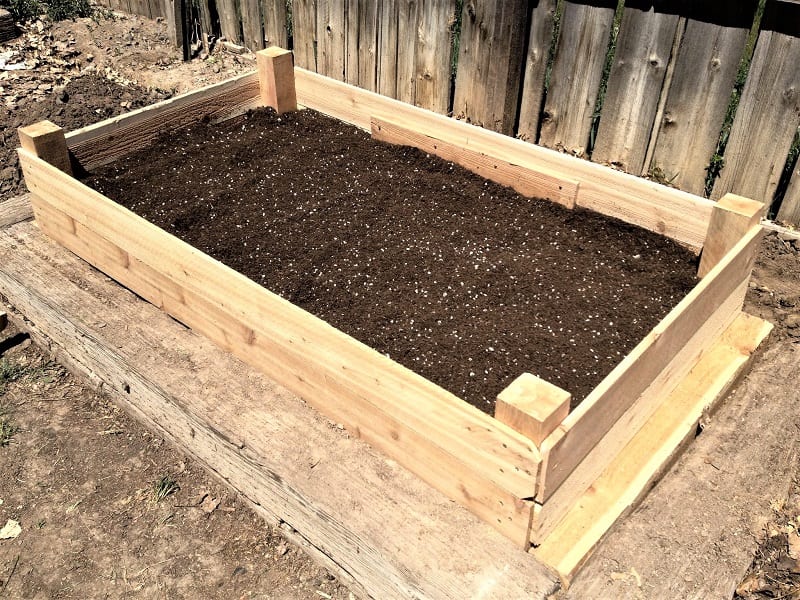
3. Fill the boxes with Mel’s Mix.
Square foot gardening relies on rich, loose soil, not the usual garden soil from your yard. The rule of thumb is to use a mixture of one part heavy compost, one part peat moss, and one part coarse vermiculite. Be sure the compost you use is true, dark compost. Consider using home-made compost rather than relying on a commercial mix.
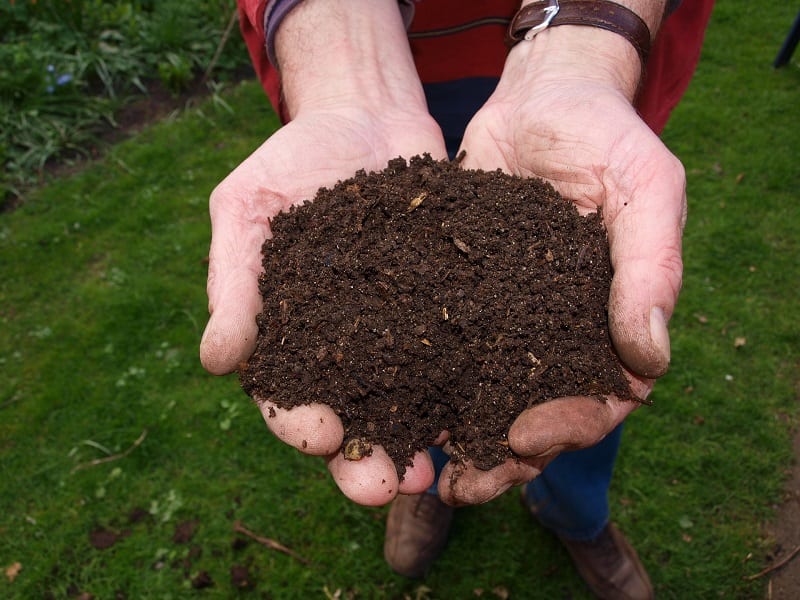
4. Divide the beds into grids.
Divide your beds into one-foot square grids. The grids will help you organize, plan, and manage your garden. If you have thin slats of scrap wood or plastic around, you can nail a grid together from these materials. Some gardeners simply use lengths of heavy string tied across the bed from nails along the edges of the box at 12-inch intervals.
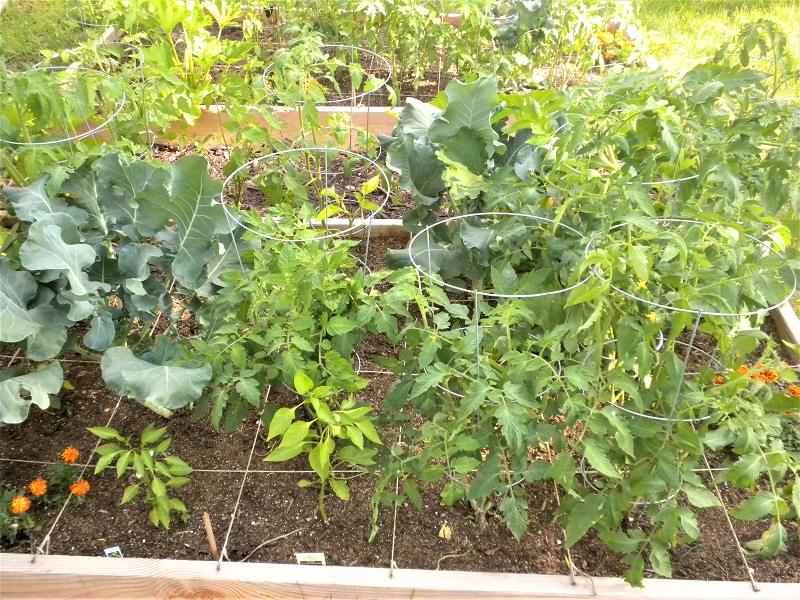
5. Plant your vegetables.
The square foot gardening method follows a planting scheme formulated around the sizes of the vegetables you want to plant. Consult the seed packets to determine how far apart you should plant each seed. Use the following format accordingly for each square:
- Extra-large vegetables: 1 seed per square (12 inches apart)
- Large vegetables: 4 seeds per square (6 inches apart)
- Medium-sized vegetables: 9 seeds per square (4 inches apart)
- Small vegetables: 16 seeds per square (3 inches apart)
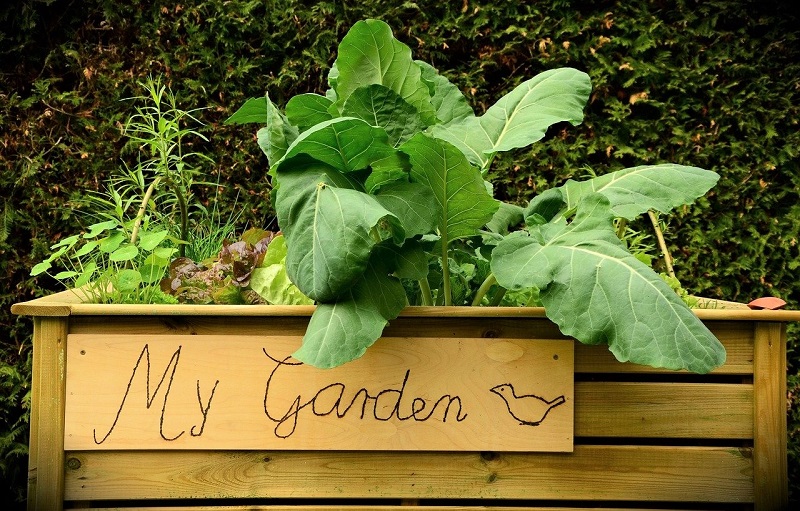
6. Grow your square-foot garden.
Note the water requirements of each vegetable you plant and water them accordingly. You should water more during hot days and dry spells. Water the raised beds deeply. Instead of watering frequently throughout the week, limit your watering schedule to only a couple of times a week but for longer periods.
Use lukewarm water in the spring, to help warm the soil. You can plant more than one crop in a square foot if you harvest the first batch early. Just add fresh compost, and replant with a mid-season crop like turnip or winter cauliflower.
You can establish a trellis on the bed to grow vining crops such as pole beans, indeterminate tomatoes, or cucumbers. Mulch the soil to conserve moisture.

Mel Bartholomew’s Harvest
The classic square-foot garden plan produces a prodigious harvest. With nine 4-by-4 raised beds, Bartholomew’s garden regularly yielded 32 carrots, 12 bunches of leaf lettuce, 18 bunches of spinach, 16 radishes, and 16 scallions.
That’s not all. The harvest was complemented by nine Japanese turnips, five pounds of peas, four heads of romaine lettuce, one head of cauliflower, and one head of broccoli.
Starting a square-foot garden is generally a safe and enjoyable activity, but it’s still essential to take some precautions to ensure your safety and the success of your garden. Here are some safety precautions to consider:
- Use Safe Gardening Tools: Use gardening tools that are in good condition and appropriate for the task at hand. Ensure that tools with sharp edges, such as pruners or shears, are used carefully and stored safely when not in use.
- Protective Gear: Wear appropriate protective gear, such as gloves and closed-toe shoes, to protect your hands and feet from cuts, scratches, and insect bites. If working with soil or compost, consider wearing a dust mask to prevent inhalation of airborne particles.
- Lift Safely: When lifting heavy objects, such as bags of soil or containers, use proper lifting techniques to avoid straining your back or other muscles. Bend your knees, keep your back straight, and lift with your legs rather than your back.
- Watch Your Step: Be mindful of your surroundings and watch out for tripping hazards, such as garden hoses, tools, or uneven terrain. Take care when walking on wet or slippery surfaces, and consider adding non-slip mats or pathways to high-traffic areas.
- Stay Hydrated: Gardening can be physically demanding, especially in hot weather, so be sure to stay hydrated by drinking plenty of water throughout your gardening session. Take regular breaks to rest and cool off if needed, especially during the hottest parts of the day.
- Protect Yourself from the Sun: If gardening outdoors, protect yourself from the sun’s harmful rays by wearing sunscreen, a wide-brimmed hat, and sunglasses. Consider gardening during the cooler morning or evening hours to avoid the strongest sun exposure.
- Avoid Toxic Plants: Familiarize yourself with common toxic plants that may be present in your garden and take precautions to avoid contact with them. Wear gloves when handling unfamiliar plants, and wash your hands thoroughly after gardening, especially before eating or touching your face.
- Be Cautious with Chemicals: If using fertilizers, pesticides, or other chemicals in your garden, always follow the manufacturer’s instructions carefully and take appropriate safety precautions. Store chemicals in their original containers, out of reach of children and pets, and wear protective gear such as gloves and goggles when handling them.
- Supervise Children and Pets: If gardening with children or pets, supervise them closely to ensure their safety. Teach children about safe gardening practices, such as not eating plants or soil, and keep pets away from potentially harmful substances or plants.
By following these safety precautions, you can enjoy a safe and successful experience while starting a square-foot garden in six effortless steps.
The Wrap Up
Embarking on the journey to start a square-foot garden in six effortless steps presents a myriad of benefits and opportunities for both novice and experienced gardeners alike. By following these straightforward steps and incorporating safety precautions, individuals can cultivate a thriving garden space that not only yields an abundance of fresh produce but also fosters a deeper connection to nature and sustainable living.
The simplicity and efficiency of square-foot gardening make it accessible to gardeners of all skill levels, offering a practical solution for maximizing space while minimizing maintenance. Through careful planning, organization, and implementation, gardeners can make a productive and visually appealing garden that enhances their outdoor environment.
Square-foot gardening encourages resource conservation, promotes healthy plant growth, and supports biodiversity through the use of raised beds, composting, and companion planting techniques. By adopting sustainable practices and cultivating a diverse range of plants, individuals can make a self-sustaining ecosystem that nourishes both the body and the soul.
Furthermore, starting a square-foot garden fosters a sense of empowerment and self-reliance, allowing individuals to take control of their food production and reduce their reliance on store-bought produce. Whether growing vegetables, herbs, or flowers, the square-foot garden provides a canvas for creativity and experimentation, encouraging gardeners to explore new varieties and techniques.
In essence, starting a square-foot garden in six effortless steps is more than just a gardening endeavor—it is a journey towards self-sufficiency, sustainability, and connection to the natural world. By embracing the principles of square-foot gardening and following these simple steps, individuals can make a flourishing garden oasis that enriches their lives and the lives of others for years to come.
Frequently Asked Questions
1. What is square-foot gardening?
Square-foot gardening is a gardening method that divides a growing area into small square sections (typically 1 foot by 1 foot), with each square dedicated to growing a different plant or crop. This method maximizes space utilization and simplifies planting, maintenance, and harvesting.
2. What are the advantages of square-foot gardening?
Square-foot gardening offers numerous advantages, including efficient use of space, reduced maintenance, higher yields per square foot, and ease of access. It’s particularly suitable for small spaces, beginner gardeners, and those looking to grow a variety of crops in a limited area.
With its simple approach, square-foot gardening is perfect for beginners who are new to gardening. The small, manageable size of each square makes it less intimidating than traditional gardening methods, allowing beginners to start small and gradually expand their garden as their confidence grows.
Square-foot gardening provides a practical and accessible entry point into the world of gardening, enabling novices to learn essential skills and techniques while enjoying the fruits of their labour.
3. How much space do you need to start a square-foot garden?
The beauty of square-foot gardening is its flexibility—it can be adapted to fit any size of space, from small raised beds or containers to larger garden plots. You can start with as little as a few square feet and expand as needed.
One of the key advantages of square-foot gardening is its scalability. You can start with just a few square feet of garden space and gradually expand as your gardening skills and ambitions grow. This incremental approach allows you to gain confidence and experience while building your garden at your pace.
Whether you’re adding additional raised beds, expanding into new areas of your yard, or incorporating vertical gardening structures, square-foot gardening can easily adapt to accommodate your evolving needs and preferences.
4. What can you grow in a square-foot garden?
Square-foot gardens can accommodate a wide variety of plants, including vegetables, herbs, flowers, and even small fruits. The key is to select plants that are well-suited to your climate and growing conditions and to follow spacing recommendations to maximize yields.
5. Do you need any special equipment or materials to start a square-foot garden?
Square-foot gardening can be done using basic gardening tools and materials, such as soil, compost, seeds or seedlings, and a measuring tool to divide the garden into squares. Raised beds or containers are optional but can make the process easier, especially for beginners.
6. How do you plan and layout a square-foot garden?
Planning a square-foot garden involves dividing the growing area into equal-sized squares and deciding what to plant in each square based on plant spacing requirements. You can use a simple grid system or make raised beds with dividers to separate the squares.
7. What are the common mistakes to avoid when starting a square-foot garden?
Common mistakes in square-foot gardening include overcrowding plants, planting too early or too late, neglecting soil preparation, and not providing adequate support for tall or vining crops. It’s essential to follow spacing recommendations, provide proper care and maintenance, and adjust planting times according to your local climate.
8. Is square-foot gardening suitable for beginners?
Yes, square-foot gardening is an excellent option for beginners due to its simplicity, efficiency, and ease of management. The small, manageable size of each square makes it less intimidating than traditional gardening methods, and it’s easy to start small and expand over time as you gain experience.
By addressing these FAQs, individuals can gain a better understanding of square-foot gardening and feel more confident about starting their garden using the six effortless steps provided.


